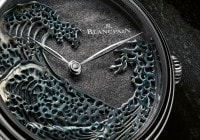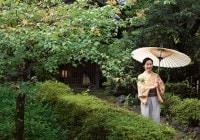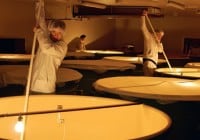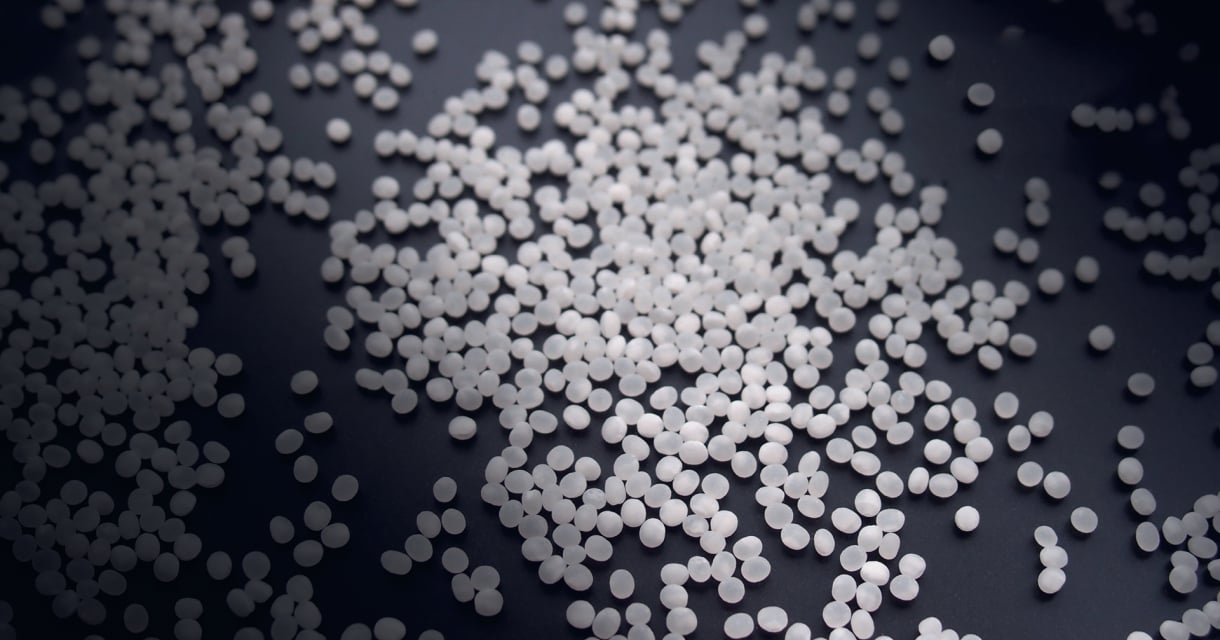
Search in Issues
Chapters
List of parts
Chapter 5
Modern JAPANESE CUISINE
New creativity keeps venerable tradition alive.
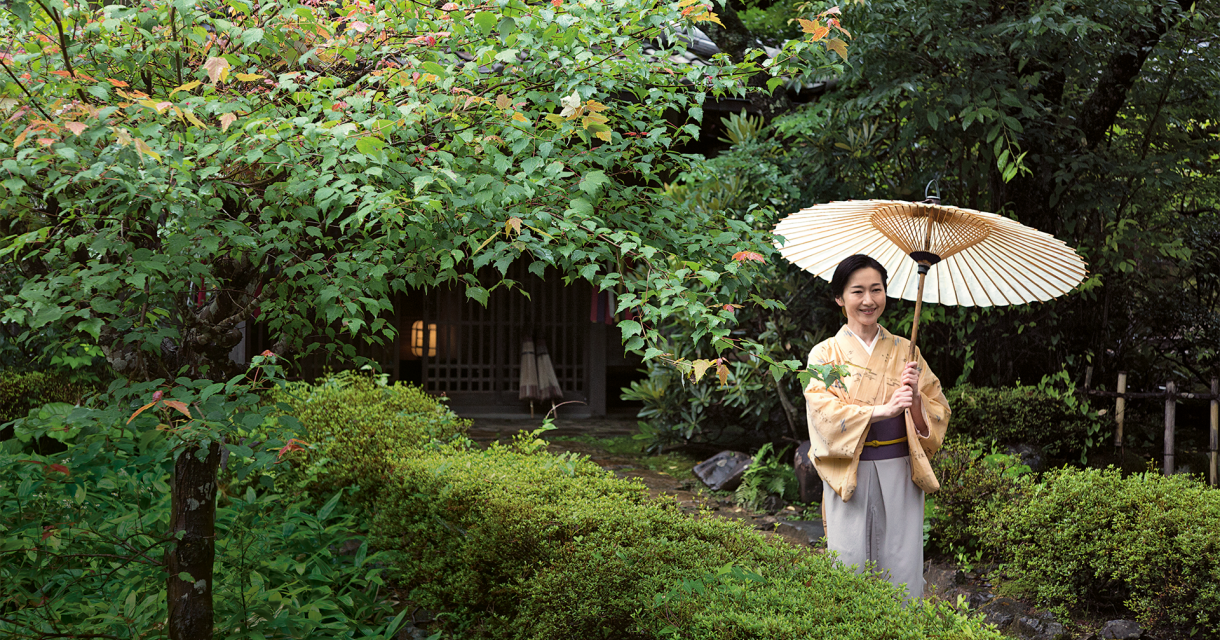
Kyoto. One of the oldest cities in Japan and its imperial capital for more than a millennium. It is the ancient center not only of government, but phi- losophy and the arts and, of course, is the birthplace of Japan’s most refined and elaborate cuisine known as kaiseki. A classic kaiseki meal offers a progression of refined, some might say “understated” courses, expressing the best of the season, and a prescribed order of cooking methods, all presented dramatically and artistically upon different serving dishes for each course. With its roots in honzenryōri from the imperial court, shojin-ryōri from Zen Buddhist monasteries that proliferate in Kyoto, and ancient tea ceremonies founded there, it is preserved and celebrated in Kyoto as nowhere else with extra precision devoted to the presentations, rituals, and methods of preparation. With its institutions, “restaurant” too feeble a term, tracing back within a single family for generations and carrying forward through those generations the precious recipes, there comes a unique intimate binding to the past that defines Kyoto kaiseki. For its loyal devotees, kaiseki’s notes and rhythms are known in advance and soothe. Yet, there are blowing in Kyoto today fresh breezes of change in the genre. Two of its most venerated and decorated meccas, Hyotei, led by its fifteenth generation, and Miyamasou, in the hands of its fourth generation, have embarked on paths injecting touches of modernity to the ancient formulae. With neither rupture nor revolution, both have discovered new and innovative interpretations that, on the one hand, fully honor their heritages and, on the other, keep them alive with subtle twists on the old rules and dictates.
The term “kaiseki” derives from two words, kai which means “bosom” and seki which means “stone”, and recalls the habit of monks who carried warm stones in their clothing thought to ward off hunger pangs. Gradually the meaning evolved into a description of a light meal. The connection to tea came with the development of the tea ceremony by Sen no Rikyu in the 1500s. The strong matcha green tea that was the central element of the ceremony was naturally very strongly caffeinated, so much so that drinking the tea on an empty stomach could cause discomfort. Rikyu’s answer was to introduce food as part of the ceremony. Originally, the food offerings were simple: a miso soup, three side dishes and rice. Gradually, the food elements of the ceremony became far more numerous and elaborate. Today, there are two main branches which spring from this history, cha-kaiseki which reprises the classic tea ceremony and the restaurant style kaiseki. Both Hyotei and Miyamasou offer kaiseki, albeit with some of the cha flourishes still found at Hyotei.
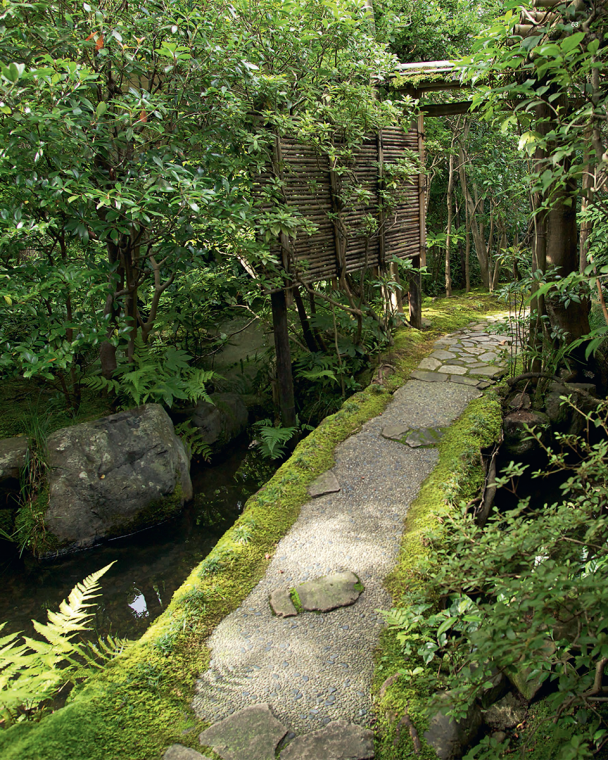
Past the portal, the entry path into Hyotei’s magic world.
Hyotei is the older of the two. Its unassuming exterior with its long yellow bamboo walls, Japanese style shingle roof, and understated gate is located in the city center equidistant from the Heian Shrine (Heian was the name of the ancient city) and the famous Zen garden of Nanzen-ji. Once past the portal, guests enter into a magic world, seemingly a continent removed from the city, featuring a slow moving brook filled with carp, lush moss covered mounds, and dense plantings of trees, bamboo and shrubs resembling a rain forest, yet too precisely organized and trimmed to call jungle to mind. Paths weave through the garden leading to separated bungalows that serve as the individual private dining rooms. One of the bungalows with a thatched roof, having survived waves of devastating fires that have periodically swept through Kyoto, dates back more than 400 years. All of the bungalows with their tatami mat and shoji wall decor offer tranquil views of the garden. Some, to accommodate in greater comfort Western guests, are equipped with foot wells, dispensing with the need to sit crosslegged in front of the traditional low Japanese lacquer serving tables.
Hyotei is today firmly in the hands of chef Yoshihiro Takahashi who took over the kitchen from his father two years ago. This is not to say, however, that the senior Takahashi (Eiichi) has retired from the scene. He still frequents the kitchen to observe and tests every new recipe developed by his son. Two unusual twists in chef Takahashi’s background prior to assuming the reins from his father. Although it is very much the norm in France for a father to train his son preparing and cementing the succession (examples: Marc Haeberlin of the Auberge de l’Ill trained by his father Paul and Michel Troisgros trained by his father Pierre and currently training his son César), that is not the practice in Kyoto. Instead, there is a chef’s network and training for succession at another restaurant is arranged through network ties. Chef Takahashi’s training took place in the Tsuruko kitchen in Kanazawa, following was mentoring under the wing of fellow Kyoto chef Yoshihiro Murata of famed Kikunoi ryōtei. An interesting crossover in this arrangement, as chef Murata himself was tutored by Yoshihiro Takahashi’s father. Strong bonds were formed so that chef Murata frequently visits to share ideas and cook alongside his former pupil.
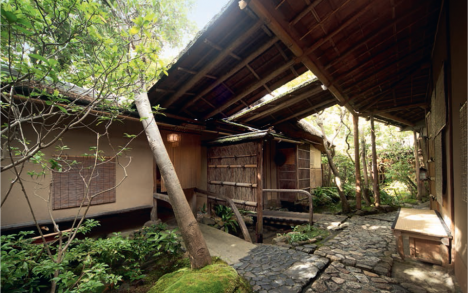
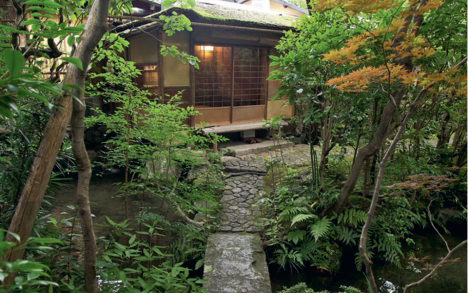
Hyotei is fiercely devoted to KYOTO TRADITION, vitalized with new innovations.
Chef Takahashi is fiercely devoted to the traditions of Kyoto kaiseki but with eyes opened to the outside world. He admits to bringing modern cooking equipment into his kitchen such as steam convection ovens, blast chillers, and sous-vide equipment. While he sees these new devices as useful for enhancing and updating preparations, he is firm that there could never be a substitute for classic grilling over traditional binchō-tan (sometimes called “white charcoal”). But his innovations go far beyond new equipment as he has been turning to new ingredients, some going to dashi which sits at the very core of kaiseki. Dashi is to Japanese cuisine as sauces are to French. Most traditionally, it is a broth made from kombu (a special seaweed)and bonito flakes (dried tuna). Proportions may vary, as may other added ingredients such as soy, sugar, mirin, ginger or sake. The kombu base, however, is a fixture. Not only is dashi ubiquitous, it is seen as an essential element in bringing umami to the plate. Umami, which can be likened to savory or meaty tastes, is often referred to as the fifth fundamental taste that we perceive in food; the others being saltiness, sweetness, sourness and bitterness. Umami is an integral part of kaiseki preparations and dashi is one of the keys to achieving it.
And chef Takahashi has developed new approaches for his dashi. In place of the kombu/bonito recipe, he has created tomato dashi. Not just one variety of tomato dashi, but several depending upon how the tomato is treated (charred, broiled, simply mashed, etc.). An example is his new recipe for octopus. He first prepares his tomato dashi then briefly blanches the octopus three times in the liquid, allowing the meat to rest between plunges. When served he adds an accent of sour plum that brings an explosion of taste to the dish. In winter he drives his new dashi in a different direction. In place of the summer tomato, the dashi is based upon root vegetable skins that have been dried in the sun.
Of course, the question presents itself. Hyotei boasts unmatched devotion by its clientele. How to introduce these innovations to those steeped in the long traditions of the house? Chef Takahashi’s answer is “very carefully”. In some cases, it has been serving a dish with two dashis, one traditional and the other new, so that the diner can chose between the familiar and the innovation. Example: a recent meal featured a sashimi course of hamo (a soft, almost cloud-like white fish seasonally available in July) and snapper, deftly sliced with the flesh in tension using a technique called ikejime which preserves its texture, offered with two sauces, a traditional soy and a new creation with tomato (grilled at 120 degrees), yuzu (a citrus) and white soy. Of course, the classic soy accompaniment was satisfying, but the tomato brought new dimensions of both brightness and excitement to both sashimis. The other has been to test a new dish with some of his most loyal diners to gauge their reactions.

Chef Yoshihiro Takahashi.
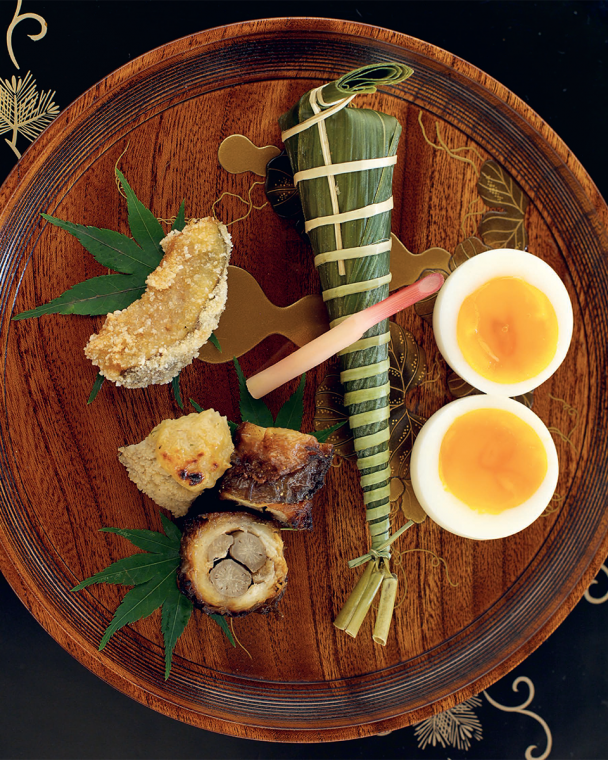
The famous Hyotei egg with fig, eel and sushi.
The HYOTEI EGG: an edible minimalist portrait of an idealized egg.
With this refreshment and new accents, chef Takahashi is swift to stress one point. He has not set out to upend Kyoto kaiseki. Instead he sees his innovations as key to keeping the kaiseki traditions alive. He is steadfast in retaining the essence and values of this revered cuisine: its progression of courses with different cooking methods (raw, steamed, fried, grilled, simmered), its unswerving ties to the perfection of seasonal ingredients, its minimalist austerity that dispenses with frills that would distract from the essence of ingredients on the plate, its artistry and poetry in the way a preparation is showcased in specially chosen serving bowls and plates.
Nowhere was fidelity to tradition more evident than a course presenting eggs, sushi, fig, octopus, eel and uni (sea urchin). If there is a single dish that calls to mind Hyotei, it is the egg. Its description is simple, banal in fact, and seemingly unfitting to a temple of high gastronomy: it consists of a boiled egg, cut in half presented with its yolk facing upwards. No sauce. No frills. No clever cooking twists such as smoking. Just the egg in all its glory. What makes it special and secures its place whenever Hyotei is mentioned is its utter perfection. The yolk is just barely set and luscious in texture; the white perfectly solid; the exterior polished without the slightest blemish. Most of all, it is the cutting that is improbable; miraculously there is not the slightest taint of yolk onto the white or the reverse. It is an edible minimalist portrait of an idealized egg. The red snapper sushi, called chimaki, was in the particular style which is a signature of Kyoto’s July Gion Festival. The rice and fish are formed into a slender cone, wrapped in a bamboo leaf and deftly tied with rush. There is art in the presentation and amusement as one unties the package. The fig nudged into new territory. Generally figs are fried with a rice cracker coating. Hyotei elevated the traditional recipe by substituting fine sesame flour for the coating. The octopus was unusual in that, instead of the tentacles, it was baby octopus coated with white miso. The grilled portion on the tray was sea eel wrapped around salsify and packing a mammoth smoky umami punch. Served alongside was a glass cup that is best described as a Japanese parfait with layers of red bell pepper and tofu purée topped with unctuous uni and a soy gelée. The uni with its gelée was a soft pillow wrapped in the velvet of the tofu cream, every bite punctuated with the surprise of a crunchy pepper bit underneath. A masterpiece.
The essence of KAISEKI is its tie to PERFECT SEASONAL INGREDIENTS.
The principal grilled dish was sea bass. Chef Takahashi, however, has refined its preparation. Instead of simply grilling the fish, he first bastes it in high temperature oil, a Chinese technique adopted by his father. The process is complicated as he bastes several times, allowing the fish to rest in between. He believes that the resting periods allow the fish to retain more of its moisture. Accents come from shiso (a Japanese herb somewhat similar to a cross between basil and mild mint), lime, vinegar and ginger. The combination was brilliant. The fish offered a perfectly crisped skin and moist sweet flesh all offset by the brightness of lime mixture.
A classic kaiseki meal always includes a simmered dish and on this occasion it was abalone, Kamo eggplant (a local Kyoto variety, round in shape) tempura, and shishito peppers in an elegantly refined traditional light dashi.
Desserts for a kaiseki meal should be light and a summer meal was no exception. Surrounded with an ethereal kirsch gelée, plainly an innovation, were succulently sweet slices of mango, white peach and melon. But a cha-kaiseki dessert is far grander than the plate itself as it is accompanied by the rituals of a Japanese tea ceremony. A luminescent bowl of foamy matcha was presented in a gorgeous lacquer bowl. As it is set before you by the kimono clad woman, it is gently given a turn before her hands are withdrawn from the service. The diner is then invited to rotate the bowl in three small increments which will bring the artwork on its side into view. As the final touch, a sweet water confection, a seasonal Kyoto specialty in summer, is offered. To bring the event to a close, the chef’s mother appeared to offer her personal greeting.
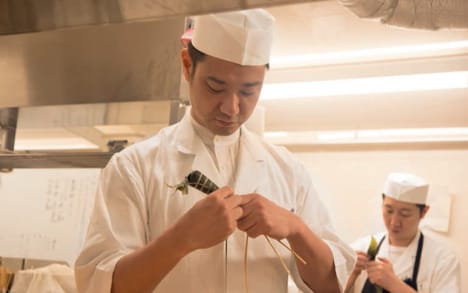
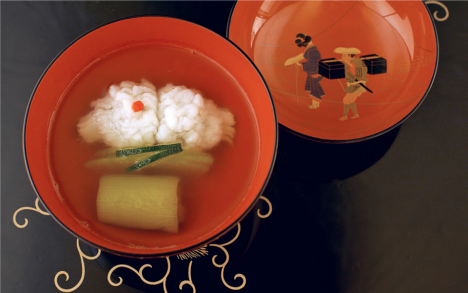
Hamo.
Miyamasou is located an hour and half ’s drive north of Kyoto on a primitive road that winds its way up the mountain side and that, in many sections, accommodates but one vehicle at a time. No need for a fence to wall off the ryokan from the outside world as its remote location insures privacy and guarantees that nothing will come between its rooms and the surrounding rain forest. If you harbor the mental image of Japan teaming with urban crowds, that will be shattered by Miyamasou’s remoteness, quiet tranquility, and isolation. Its integration into the dense forest and the stream that flows next to lodging rooms cast a spell. It is off the grid and all temptations to dive into the small screens that we all carry vaporize.
Miyamasou is a family ryokan presided over by chef Hisato Nakahigashi and his wife. It has been in the family for 110 years. Although much of chef Nakahigashi’s cooking philosophy was learned from his father, following Japanese convention, his training took him away from Miyamasou. Before working in another Japanese kitchen, he journeyed to France. However, rather than apprentice in the back of the house tending the stoves, Nakahigashi chose a role as a waiter. He wanted to learn how guests related to their meals and the restaurant experience. This took him to Paris and finally to Eugénie-les-Bains with three-star chef Michel Guérard. Only upon his return to Japan did he train in a Japanese kitchen, at Tsuruko in the Ishikawa Prefecture (far western Japan). Sadly, his homecoming back to Miyamasou only occurred after his father’s passing.
One of the hallmarks of kaiseki is its unswerving dedication to the best local ingredients. But what is “local”? Miyamasou takes matters to the extreme. For chef Nakahigashi, “local” means searching for ingredients in the wild environs surrounding the ryokan. Thus, for example, all fish served is from the fresh waters in the mountains, as the sea, although not significantly remote from Kyoto, is not truly “local”. Likewise, his vegetables are sourced from adjacent parcels. But here, too, he is zealous in his selections. Not only does he seek vegetables grown in the environs, he favors those that grow wild rather than those that might be cultivated. His sole interference in his natural gardens is the erection of fences to protect the plants from wild animals. Apart from that, he wants their growth to be unmanipulated and wild. And what difference does he perceive when compared to cultivated crops? He believes that there are unique
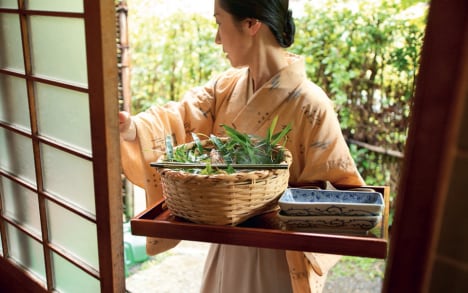
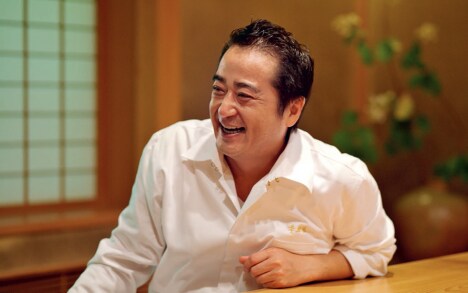
Chef Hisato Nakahigashi.
VEGETABLES are the STARS at Miyamasou.
dimensions that are expressed by the plants when they compete with other plants. For chef Nakahigashi not only is the true nature found with unmanipulated growth, but by studying the growth cycles, how the plants live and when they thrive, he is better able to understand how to incorporate them in his cooking. Locality and wildness also are trademarks during game season as his meats-bear, deer, wild boar-come from the surrounding mountains.
This dedication to foraging in his “gardens” makes vegetables the star ingredients in Nakahigashi’s cuisine. Case in point. A preparation of wagyu beef. Ordinarily, in the conception of a beef dish, chefs be- gin with the meat before turning to its accompaniments and cooking method. Chef Nakahigashi began his creation with a leaf. A kuzu leaf from a tree growing on the property to be more precise. He wanted to find a way to cook something wrapped in kuzu and that would absorb its perfume. So what some might consider a beef dish, in fact, is a leaf dish. Three years were spent perfecting the preparation. The unctuously fat wagyu is marinated for three days in a mixture of miso, mirin, and soy. It then is wrapped in the kuzu leaf and topped with sansho pepper flowers (sansho is a form of Japanese pepper) and cooked slowly at the very low temperature of 43 degrees. The result is triumphant. The fat in the beef absorbs the marinade, transforming the entirety in texture and taste so as to resemble foie gras with notes of the leaf and pepper as counterpoints.
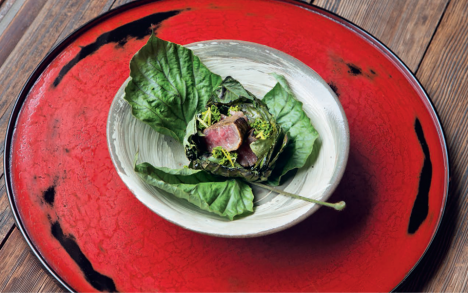
Wagyu beef in kuzu leaf.
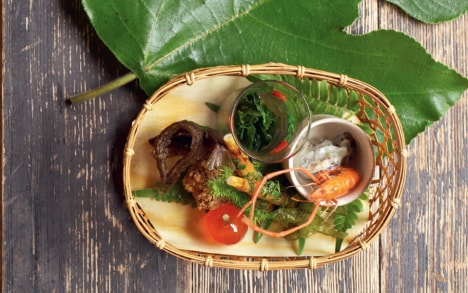
Hassun course.
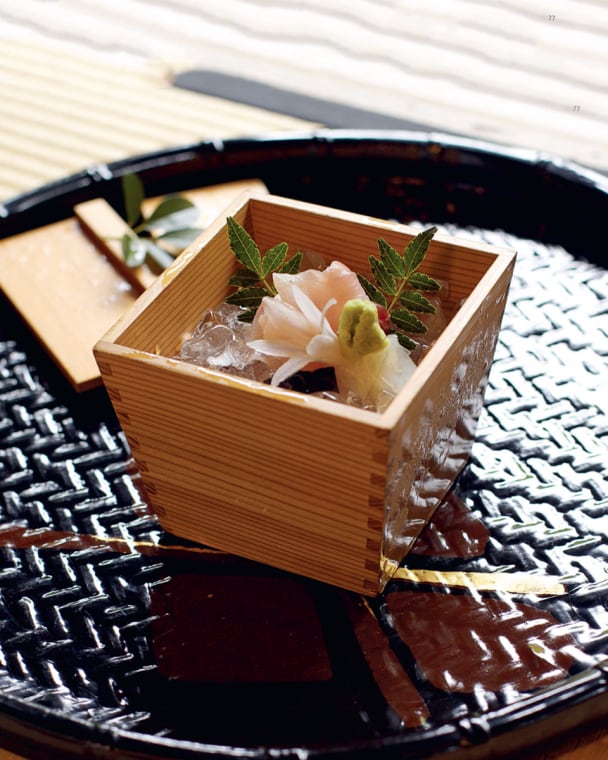
Carp sashimi served on ice.
Miyamasou features VEGETABLES GROWN WILD in its gardens.
It is traditional in a kaiseki meal to have a second course, termed hassun, to establish the seasonal theme. Miyamasou’s interpretation was a medley in a basket with blanched herbs from the mountain; cucumber, shiitake and local herbs in a tofu dressing; a spear of teriyaki baby bamboo; fried konnyaku (sometimes called “devil’s tongue”) with a rice cracker coating; shrimp with edamame; and a cured egg yolk. All were excellent. The cucumber retained all of its crunch, undiluted by the creamy tofu dressing. The bamboo astonishingly delicate and tender. The standout, however, was the egg yolk. Nakahigashi marinates the yolk for three days in miso which brings about a transformation akin to Gouda cheese, right down to the brilliant red color of the exterior.
The attention to minute detail that marks all of Japanese cooking, but especially kaiseki, was on full display with the wild river carp sashimi course. Carp is notable for its firm, almost chewy texture which would be diminished with the slightest error in slicing or temperature control. Slicing was done table side. Deftly slashed, each slice was carefully laid upon ice before serving in a wooden box filled with more ice. Served alongside was a square of mild flavored river moss, an edible flower and freshly grated wasabi.
Of course, Miyamasou followed the sashimi with a vegetable dish, presenting vividly contrasting colors of yellow tomato, red bell pepper and wild mountain asparagus, all accented with a delicate yuzu/miso glaze. Each element was at its seasonal peak.
For a brief period during the summer, it is the time for ayu, a small local river fish. Miyamisou hewed to the tradition of grilling the fish over binchō-tan charcoal. Classicism as well in the method of grilling, with each fish speared lengthwise, its body formed into a gentle vertical S shape to ensure that cooking along its length would be even. Ayu is eaten in its entirety, head to tail, the different body sections with unique tastes progressing from slightly bitter at the head to sweet toward the tail. A vinegar/herb sauce is served alongside.
Miyamasou’s emphasis on vegetables produced a second vegetable course, this one centered on Japanese water eggplant and cucumber. The eggplant was cooked slowly in the oven until its skin burned off bringing smoky overtones to the remaining flesh. As both the eggplant and cucumber are mild in flavor, Nakahigashi brought punch to the preparation with a classic kombu-bonito-dashi gelée and kinome (a local peppery herb).
Pickles are a fixture of every kaiseki ballade, and restaurants of Miyamasou’s stature, of course, brine their own. Indeed, chef Nakahigashi has a dedicated cellar for his brined, long marinated and fermented preparations. So important is this to his cooking that he has plans to construct a much larger cellar in the coming year. There is a freshness and delicacy to the pickles that can never be found in the local markets. The pickles and a sour plum condiment were served alongside the rice topped with sweetly marinated fish.
Naturally, the mountain was the source of the dessert. The centerpiece was a wild plum which had been simmered in wine and served with pine nut milk curd all surrounded by a refined and understated wild mint gelée. The balance was perfect as the pine nut milk rounded off the bright acidic flavors of the plum.
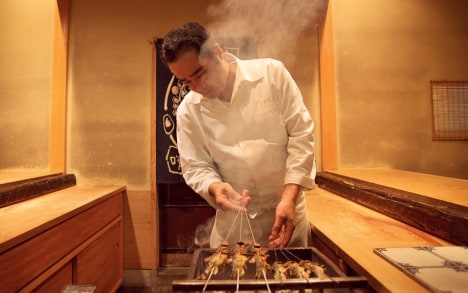
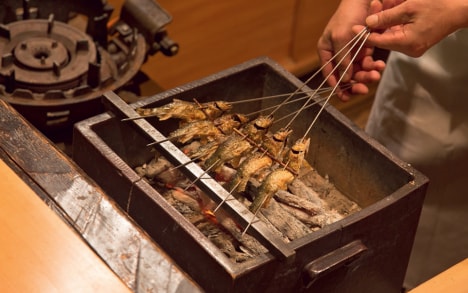
Grilling ayu over bincho-tan charcoal.
When speaking of the evolution of the most traditional Japanese cuisine, sushi in Tokyo should not be overlooked. Kyoto is known for its reverence to its cooking roots; Tokyo is not similarly constrained. It is a pulsing city that acknowledges no boundaries. One statistic offers a glimpse at its diversity; Tokyo is home to 300,000 restaurants. To appreciate the power of that number, compare New York with but 30,000. So if you want to look, and no particular effort required, you can find anything in Tokyo. Innovative. Never before tried. The good. The bad. The ludicrous. It’s all there. Hammering home even further Tokyo’s choices, there are 300 sushi restaurants in the Ginza alone!
But sushi is different. Here there are rules, even in Tokyo. Nonetheless, operating within that framework that defines the genre, innovation and modernity are appearing. Sushi Tokami in the Ginza makes the case.
In common with the finest sushi restaurants in Tokyo, Sushi Tokami is miniscule. Its counter accommodates but ten guests. Counter seating is the norm at this level of sophistication and the making of the sushi is placed in plain view. Personal service by the chef is what is expected.
Presiding over Sushi Tokami is owner chef Hiroyuki Sato. The career path to becoming a sushi chef is never short and chef Sato’s ascension was no exception. He actually began working as a waiter before he realized that, in Japan, the long-term possibilities were limited. Fortuitously, his father had a sushi shop giving chef Sato a bit of a head start in understanding the genre. He began his formal training at a variety of different sushi restaurants with his longest sojourn, six years, at Akizuki, a famed sushi restaurant in Shibuya, Tokyo. Even after training for several years, he still was not allowed to serve guests. That role was reserved for the master chef. Gradually, however, the master chef at Akizuki allowed Sato to make and serve sushi for him after the restaurant’s closure and using the evening’s leftovers. Receiving the chef ’s critiques and pointers from this after-hours service, Sato was able to hone and perfect his technique.
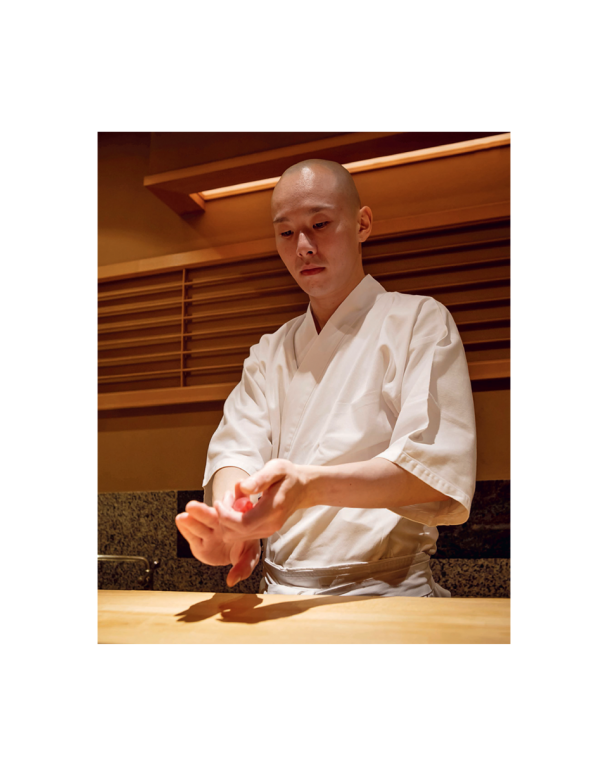
Chef Hiroyuki Sato.
Sato points out that some say “anyone can make sushi”, but he believes that the secret to the best sushi is in the finely trained hands of the chef. Novices focus on the fish and of course the selection and slicing are vital. To the masters, however, it is devotion to the rice and its feel that elevates the art. Rice changes every day as it reacts to its age, humidity and temperature. When the rice is first harvested it contains a lot of water. Gradually it dries. Chef Sato believes that, in general, it is best after one year’s aging. But there is no set time or formula. He checks it every single day. His preference is for a particular hybrid that he specifies and that comes from northern Japan in the Yamagata Prefecture. The supplier is important not only to insure the quality as grown but the precision of the polishing. The polishing must be delicately applied to guarantee that there is no breakage.
Every morning finds him at the Tsukiji fish market located in Tokyo’s harbor. He has developed special relationships with purveyors, one for tuna, one for uni and one for shellfish, who each prepare special boxes for him. From those boxes he makes his own selections with an eye toward those that will best pair with his style of rice. Adding to the complexity of his decisions is the question of aging. To many less experienced devotees, it is thought that all sushi fish is served as soon as possible after it is caught. That is not always true. Aging of some tuna parts for up to a week is done, with the chef checking frequently to determine when the time is perfect.
Kombu deserves special attention and chef Sato brings to its preparation his own philosophy. He prefers kombu that has been aged for five years. This endows it with particularly rich umami.
The norm in the Tokyo sushi world is to incorporate white vinegar into the rice. At Sushi Tokami red vinegar made from sake lees is used and the fish is chosen to mate with the extra rich umami that comes from this departure from the usual. Not only is the flavor accent different, slightly acidic and bright rather than sweet, so is the color as the rice takes on an amber hue.
At simple sushi restaurants, one plunges immediately into the sushi nigiri. Nigiri is the classic sushi presentation of a slice of fish (neta) perched atop a small hand-formed mound of rice (shari). Nigiri’s origins date back 200 years, not as a grand dining experience, but as a simple piece of fish from the day’s catch placed upon rice and sold by Tokyo street vendors to passersby as a convenient form of fast food to go!
For a prestige house like Sushi Tokami the meal begins with a rich range of entrées coming well before the start of nigiris. Sushi Tokami’s serving style is omakase, which means the chef decides upon the particular menu for the meal. The first starter consisted of ethereally tender tosaki (red tuna meat taken from where the head joins the backbone) around which he rolled a microscopically thin nori (seaweed) wrapper. Visually, it presented itself as a green spring roll. Tosaki, extremely rare, is notable for its extraordinarily rich flavor and soft texture. Unlike nori from lesser sushi restaurants, his nori delicately shattered to the tooth and was both refined and mild drawing no attention to itself or away from the tuna.
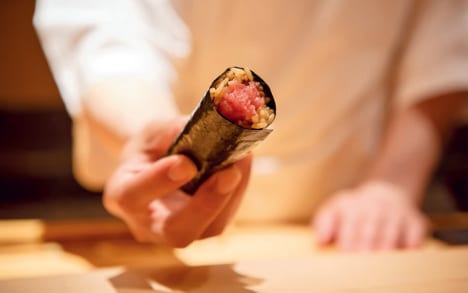
Tosaki.

Sushi Tokami’s rice accented by red vinegar.
Novices focus upon the fish; for the sushi MASTERS it is the RICE that elevates the art.
This was followed by junsai (gelatinous sprouts with a brief summer season), uni, and steamed awabi (abalone). This combination was an expression of three forms of subtle delicacy, each ingredient bringing a different interpretation. Alongside, a dish of two morsels of slightly charred anago (sea eel), one topped with wasabi, the other with sour plum. Each topping served as a counterpoint to the richness of the eel.
Next up three very small ayu that had been fried until crisp and served with a sour vinegar gelée. Waves of sensations from the combination, which paired a rustic texture with the refinement of the fish’s taste.
A standout entrée was monkfish foie gras with kale, fresh mushrooms and microtomato. The preparation truly evoked traditional French duck liver foie gras, in richness, taste and texture.
The final entrée was a type of barracuda, marinated in nukazuke (a Japanese pickling ingredient made from fermented rice bran and normally used for pickling eggplant). Two strips of Kyoto bell peppers were placed atop. Waves of umami of show stopping depth and power from the preparation.
Eventually, the meal turned to a parade of sushi nigiri. The breadth was staggering. Of course, there were the three types of maguro tuna: red (marinated in soy), medium fat (chūtoro) and fatty (ōtoro). All three grades were sliced from the same fish. Chef Sato inclines toward smaller sized tuna (around 30–70 kg in weight). What difference does he find when compared to larger sizes? Diet. The smaller fish live in shallower water near the shore, rich with small fish that eat plankton near the mouth of rivers. All three showed the wisdom of his preference for aged vinegar bringing a brightness to marry with the richness of the tuna.
Two preparations made use of his aged kombu, kohada (a seasonal white fish) which he marinated in vinegar and sake and a lovely sweet smelt (sillaginoid) wrapped in kombu whose sweetness was deepened with kombu’s umami.
Remarkable was hamaguri (cherry clam) which was cooked at a low temperature which both enhanced its sweetness and preserved its naturally chewy texture. Served alongside was sugared classic dashi.
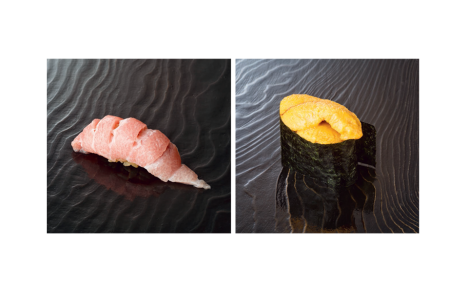
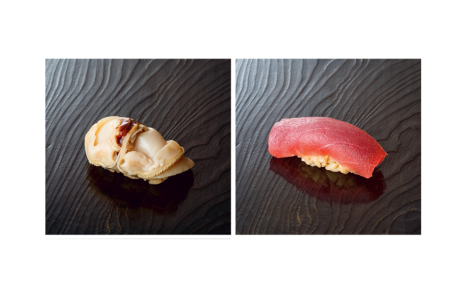
Varieties of sushi nigiri, clockwise from upper left: otoro, uni, red tuna, eel.
All three featured restaurants have been awarded MICHELIN STARS.
Two yin/yang preparations were on the evening’s menu. The first was an utterly innovative preparation of uni. Chef Sato combined uni of two different temperatures, warm and cold. The sensations on the tongue were intriguing, as one encountered first the tantalizing cold followed by the soothing warm. Brilliant. Next up was nodo guro (black throated sea perch) which was first marinated in kombu and then quickly charred, skin only. Again it was the contrast that drew attention. The skin had a delicate crunch from the charring, while the uncooked meat retained a delicate ethereal texture that vaporized in the mouth.
Two versions of anago (eel) were presented side by side. One steamed with a soy-sugar-mirin sauce with dashi; the other char cooked with salt and yuzu. The steamed version, served warm, gave the impression of a soft pillow. The charred version delivering a firmer punch.
Naturally there was a miso soup. Chef Sato here drifts toward French technique as he infuses the broth with bones and fish morsels.
A classic conclusion to a sushi meal is the Japanese style sweet omelet. Here, too, French accents appeared. The top of the brilliantly yellow custard had been torched and crisped à la crème brûlée.
Sampling great cuisine should never mimic a tour of a dusty museum. Life and vibrancy coupled with respect for tradition give the greatest rewards and it is exciting to see these venerated classic cuisines of kaiseki and sushi freshened and evolving.1
1 All three restaurants have been rewarded by the Guide Michelin with stars: Hyotei with three, Miyamasou with two, and Sushi Tokami with one.

Miso soup.
Other issues
Don't miss the latest issue
Sign Up for New Releases

